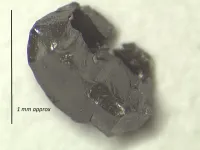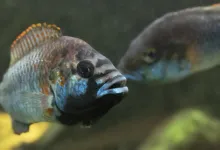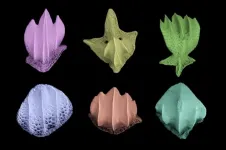(Press-News.org) A unique study of ancient diamonds has shown that the basic chemical composition of the Earth's atmosphere which makes it suitable for life's explosion of diversity was laid down at least 2.7 billion years ago. Volatile gases conserved in diamonds found in ancient rocks were present in similar proportions to those found in today's mantle, which in turn indicates that there has been no fundamental change in the proportions of volatiles in the atmosphere over the last few billion years. This shows that one of the basic conditions necessary to support life, the presence of life-giving elements in sufficient quantity, appeared soon after Earth formed, and has remained fairly constant ever since.
Presenting the work at the Goldschmidt Geochemistry conference, lead researcher Dr Michael Broadly said, "The proportion and make-up of volatiles in the atmosphere reflects that found in the mantle, and we have no evidence of a significant change since these diamonds were formed 2.7 billion years ago".
Volatiles, such as hydrogen, nitrogen, neon, and carbon-bearing species are light chemical elements and compounds, which can be readily vaporised due to heat, or pressure changes. They are necessary for life, especially carbon and nitrogen. Not all planets are rich in volatiles; Earth is volatile rich, as is Venus, but Mars and the Moon lost most of their volatiles into space. Generally, a planet rich in volatiles has a better chance of sustaining life, which is why much of the search for life on planets surrounding distant stars (exoplanets) has focused on looking for volatiles.
On Earth, volatile substances mostly bubble up from the inside of the planet, and are brought to the surface through such things as volcanic eruptions. Knowing when the volatiles arrived in the Earth's atmosphere is key to understanding when the conditions on Earth were suitable for the origin and development of life, but until now there has been no way of understanding these conditions in the deep past.
Now French and Canadian researchers have used ancient diamonds as a time capsule, to examine the conditions deep inside the Earth's mantle in the distant past. Studies of the gases trapped in these diamonds show that the volatile composition of the mantle has changed little over the last 2.7 billion years.
Lead researcher, Michael Broadley (University of Lorraine, France) said "Studying the composition of the Earth's modern mantle is relatively simple. On average the mantle layer begins around 30km below the Earth's surface, and so we can collect samples thrown up by volcanoes and study the fluids and gases trapped inside. However, the constant churning of the Earth's crust via plate tectonics means that older samples have mostly been destroyed. Diamonds however, are comparatively indestructible, they're ideal time capsules".
We managed to study diamonds trapped in 2.7 billion year old highly preserved rock from Wawa, on Lake Superior in Canada. This means that the diamonds are at least as old as the rocks they are found in - probably older. It's difficult to date diamonds, so this gave us a lucky opportunity to be sure of the minimum age. These diamonds are incredibly rare, and are not like the beautiful gems we think of when we think of diamonds. We heated them to over 2000 C to transform them into graphite, which then released tiny quantities of gas for measurement".
The team measured the isotopes of Helium, Neon, and Argon, and found that they were present in similar proportions to those found in the upper mantle today. This means that there has probably been little change in the proportion of volatiles generally, and that the distribution of essential volatile elements between the mantle and the atmosphere are likely to have remained fairly stable throughout the majority of Earth's life. The mantle is the part between the Earth's crust and the core, it comprises around 84% of the Earth's volume.
Dr Broadley continued "This was a surprising result. It means the volatile-rich environment we see around us today is not a recent development, so providing the right conditions for life to develop. Our work shows that these conditions were present at least 2.7 billion years ago, but the diamonds we use may be much older, so it's likely that these conditions were set well before our 2.7 billion year threshold".
Commenting, Dr Suzette Timmerman (University of Alberta, Canada) said:
"Diamonds are unique samples, as they lock in compositions during their formation. The Wawa fibrous diamonds specifically were a great selection to study - being more than 2.7 billion years old - and they provide important clues into the volatile composition in this period, the Neoarchean period. It is interesting that the upper mantle already appears degassed more than 2.7 billion years ago. This work is an important step towards understanding the mantle (and atmosphere) in the first half of Earth's history and leads the way to further questions and research".
Dr Timmerman was not involved in this work, this is an independent comment.
INFORMATION:
The Goldschmidt Conference is the World's main geochemistry conference. It is hosted alternately by the European Association of Geochemistry (Europe) and the Geochemical Society (USA). The 2021 conference (virtual) takes place from 4-9 July, https://2021.goldschmidt.info/. The 2022 conference takes place in Hawaii.
Below please find summaries of new articles that will be published in the next issue of Annals of Internal Medicine. The summaries are not intended to substitute for the full articles as a source of information. This information is under strict embargo and by taking it into possession, media representatives are committing to the terms of the embargo not only on their own behalf, but also on behalf of the organization they represent.
1. Infusion centers associated with substantially better outcomes than the ER for patients with acute pain events and sickle cell disease
Abstract: https://www.acpjournals.org/doi/10.7326/M20-7171
Editorial: https://www.acpjournals.org/doi/10.7326/M21-2650
Summary: ...
LAWRENCE -- A new paper from a lead author based at the University of Kansas finds wetlands constructed along waterways are the most cost-effective way to reduce nitrate and sediment loads in large streams and rivers. Rather than focusing on individual farms, the research suggests conservation efforts using wetlands should be implemented at the watershed scale.
The paper, just published in the Proceedings of the National Academy of Sciences, relied on computer modeling to examine the Le Sueur River Basin in southern Minnesota, a watershed subject to runoff from intense agricultural production of corn and soybeans -- crops characteristic of the entire ...
In the movie "A Fish Called Wanda", the villain Otto effortlessly gobbles up all the occupants of Ken`s fish tank. Reality, however, is more daunting. At least one unfortunate fan who re-enacted this scene was hospitalized with a fish stuck in the throat. At the same time this also was a painful lesson in ichthyology (the scientific study of fishes), namely that the defense of some fishes consists of needle-sharp fin spines.
Two types of fin elements
Indeed, many fish species possess two types of fin elements, "ordinary" soft fin rays, which are blunt and flexible and primarily serve locomotion, and fin spines, which are sharp and heavily ossified. As fin spines serve the ...
For 400 million years, shark-like fishes have prowled the oceans as predators, but now humans kill 100 million sharks per year, radically disrupting ocean food chains. Based on microscopic shark scales found on fossil- and modern coral reefs in Caribbean Panama, Smithsonian scientists reveal the changing roles of sharks during the last 7000 years, both before and after sharks in this region were hunted. They hope this new use for dermal denticles will provide context for innovative reef conservation strategies.
Microscopic scales covering a shark's body--dermal ...
A study published the week of July 5 in the Proceedings of the National Academy of Sciences led by Michael Moore at Washington University in St. Louis finds that dragonfly males have consistently evolved less breeding coloration in regions with hotter climates.
"Our study shows that the wing pigmentation of dragonfly males evolves so consistently in response to the climate that it's among the most predictable evolutionary responses ever observed for a mating-related trait," said Moore, who is a postdoctoral fellow with the Living Earth Collaborative at Washington University.
"This work reveals that mating-related traits can be just as important to how organisms ...
Scientists recently made news by using fossil shark scales to reconstruct shark communities from millions of years ago. At the same time, an international team of researchers led by UC Santa Barbara ecologist Erin Dillon applied the technique to the more recent past.
Human activities have caused shark populations to plummet worldwide since records began in the mid-20th century. However, the scientists were concerned that these baseline data may, themselves, reflect shark communities that had already experienced significant declines. Dillon compared the abundance and variety of shark scales from a Panamanian coral reef 7,000 years ago to those in reef sediments ...
A vast seabird colony on Ascension Island creates a "halo" in which fewer fish live, new research shows.
Ascension, a UK Overseas Territory, is home to tens of thousands of seabirds - of various species - whose prey incudes flying fish.
The new study, by the University of Exeter and the Ascension Island Government, finds reduced flying fish numbers up to 150km (more than 90 miles) from the island - which could only be explained by the foraging of seabirds.
The findings - which provide rare evidence for a long-standing theory first proposed at Ascension - show how food-limited seabird populations naturally are, and why they are often so sensitive to competition with human fishers. ...
Nanomaterials found in consumer and health-care products can pass from the bloodstream to the brain side of a blood-brain barrier model with varying ease depending on their shape - creating potential neurological impacts that could be both positive and negative, a new study reveals.
Scientists found that metal-based nanomaterials such as silver and zinc oxide can cross an in vitro model of the 'blood brain barrier' (BBB) as both particles and dissolved ions - adversely affecting the health of astrocyte cells, which control neurological responses.
But the researchers also believe that their discovery will help to design safer nanomaterials and could open ...
Like female voles, connections between oxytocin neurons in the hypothalamus and dopamine neurons in reward areas drive parental behaviors in male voles, according to new research published in JNeurosci.
Motherhood receives most of the attention in the research world, yet in 5% of mammals -- including humans -- fathers provide care, too. The "love hormone" oxytocin plays a role in paternal care, but the exact neural pathways underlying the behavior were not known.
He et al. measured the neural activity of vole fathers while they interacted with their offspring. Oxytocin neurons connecting the hypothalamus to a reward area fired when the fathers cared for their offspring. ...
The psychedelic drug psilocybin, a naturally occurring compound found in some mushrooms, has been studied as a potential treatment for depression for years. But exactly how it works in the brain and how long beneficial results might last is still unclear.
In a new study, Yale researchers show that a single dose of psilocybin given to mice prompted an immediate and long-lasting increase in connections between neurons. The findings are published July 5 in the journal Neuron.
"We not only saw a 10% increase in the number of neuronal connections, but also they were on average about 10% larger, so the connections were stronger as well," said Yale's Alex Kwan, associate professor of psychiatry and of neuroscience and senior author of the paper.
Previous ...





